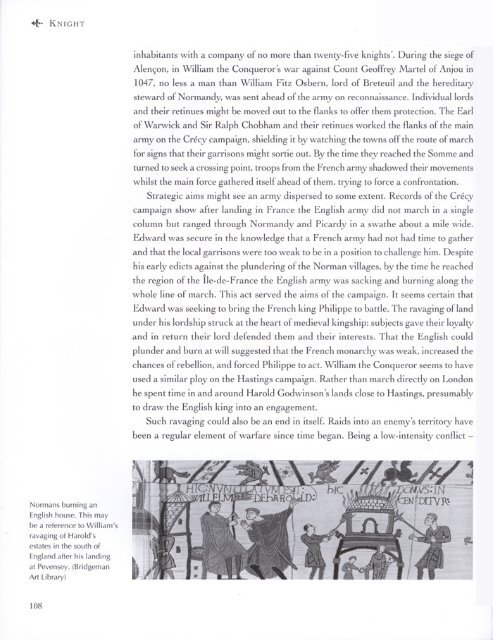Osprey - General Military - Knight - The Warrior and ... - Brego-weard
Osprey - General Military - Knight - The Warrior and ... - Brego-weard
Osprey - General Military - Knight - The Warrior and ... - Brego-weard
Create successful ePaper yourself
Turn your PDF publications into a flip-book with our unique Google optimized e-Paper software.
KNIGHT<br />
Normans burning an<br />
English house. This may<br />
be a reference to William's<br />
ravaging of Harold's<br />
estates in the south of<br />
Engl<strong>and</strong> after his l<strong>and</strong>ing<br />
at Pevensey. (Bridgeman<br />
Art Library)<br />
108<br />
inhabitants with a company ol no more than twenty-five knights'. During the siege of<br />
Alcncj'on, in William the Conqueror's war against Count Geoffrey Martel of Anjou in<br />
1047, no less a man than William Fitz Osbern, lord of Breteuil <strong>and</strong> the hereditary<br />
steward of Norm<strong>and</strong>y, was sent ahead of the army on reconnaissance. Individual lords<br />
<strong>and</strong> their retinues might be moved out to the flanks to offer them protection. <strong>The</strong> Earl<br />
ol Warwick <strong>and</strong> Sir Ralph Chobham <strong>and</strong> their retinues worked the flanks of the main<br />
army on the Crecy campaign, shielding it by watching the towns off the route of march<br />
for signs that their garrisons might sortie out. By the time they reached the Somme <strong>and</strong><br />
turned to seek a crossing point, troops from the French army shadowed their movements<br />
whilst the main force gathered itself ahead of them, trying to force a confrontation.<br />
Strategic aims might see an army dispersed to some extent. Records of the Crecy<br />
campaign show after l<strong>and</strong>ing in France the English army did not march in a single<br />
column but ranged through Norm<strong>and</strong>y <strong>and</strong> Picardy in a swathe about a mile wide.<br />
Edward was secure in the knowledge that a French army had not had time to gather<br />
<strong>and</strong> that the local garrisons were too weak to be in a position to challenge him. Despite<br />
his early edicts against the plundering of the Norman villages, by the time he reached<br />
the region of the Ile-de-France the English army was sacking <strong>and</strong> burning along the<br />
whole line of march. This act served the aims of the campaign. It seems certain that<br />
Edward was seeking to bring the French king Philippe to battle. <strong>The</strong> ravaging ot l<strong>and</strong><br />
under his lordship struck at the heart ol medieval kingship: subjects gave their loyalty<br />
<strong>and</strong> in return their lord defended them <strong>and</strong> their interests. That the English could<br />
plunder <strong>and</strong> burn at will suggested that the French monarchy was weak, increased the<br />
chances of rebellion, <strong>and</strong> forced Philippe to act. William the Conqueror seems to have<br />
used a similar ploy on the Hastings campaign. Rather than march directly on London<br />
he spent time in <strong>and</strong> around Harold Godwinson's l<strong>and</strong>s close to Hastings, presumably<br />
to draw the English king into an engagement.<br />
Such ravaging could also be an end in itself. Raids into an enemy's territory have<br />
been a regular element of warfare since time began. Being a low-intensity conflict -<br />
•VSW<br />
HTVR-







